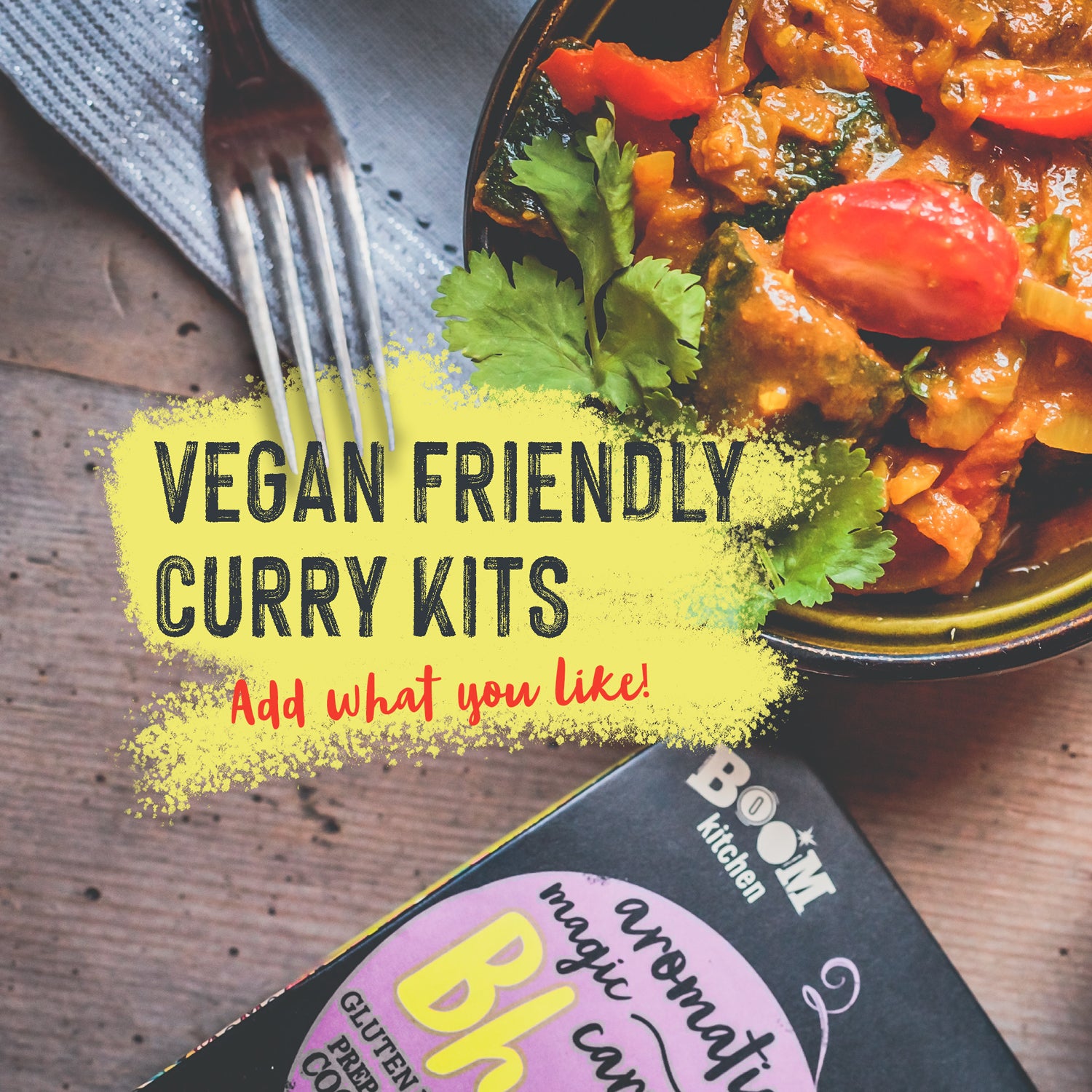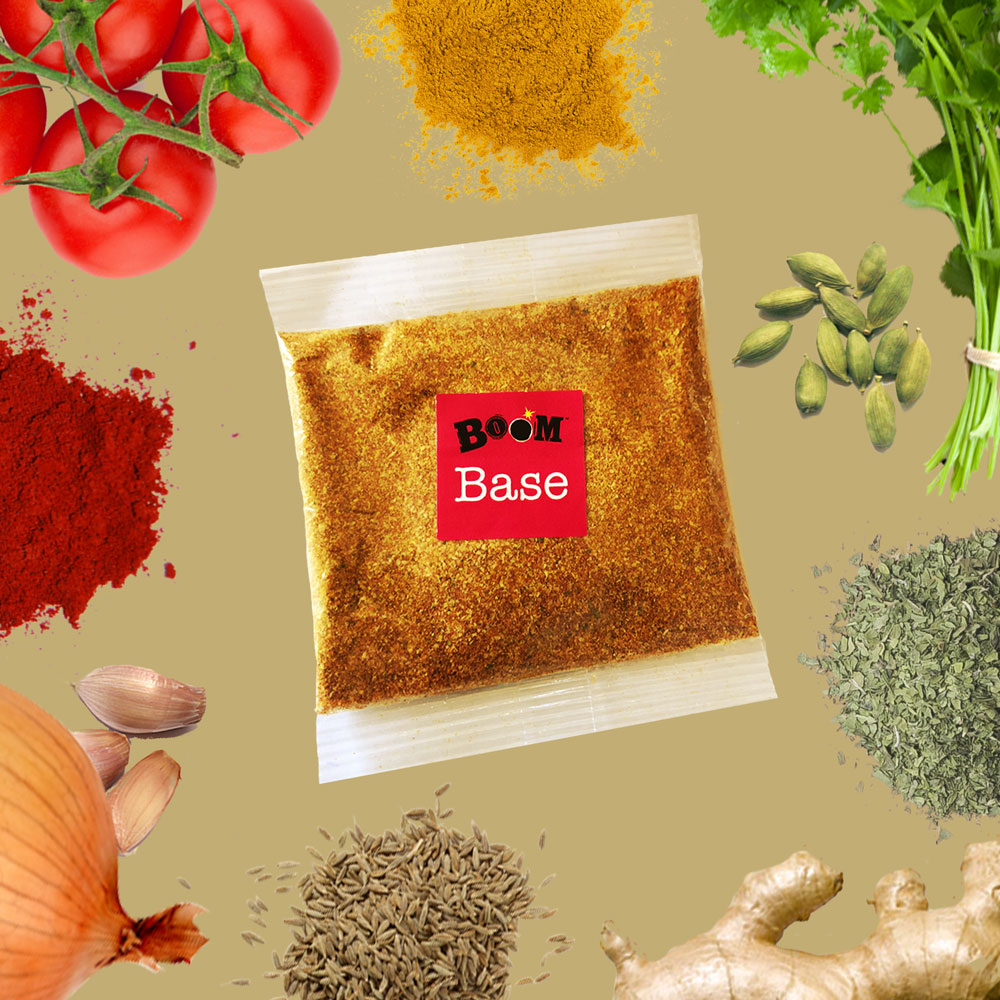It's International Vegan Month, and we wanted to take a moment to introduce a few of our vegan friendly curry kits to our vegan customers, and those who simply fancy giving meat a rest for a meal or two. Make sure to check out our delicious Aubergine and Sweet Potato Tagine recipe.
Our mantra is if you're going to eat meat make sure it's good quality. The good stuff is more expensive, so we think whether you're vegan or not it's good for everyone to have some tasty vegan recipes up their sleeve.
All of our award winning curry kits are natural, gluten free, and vegan friendly. So, if you pick up some Boom kits you'll be off to a good start already.
International Vegan Month
International Vegan Month runs for the whole of November. It's a great excuse to expand your cooking repertoire and experiment with plant based curries. Some of our favourite Boom curry recipes just so happen to be vegan. Not only are they delicious, they typically come in a few quid cheaper than the carnivore's equivalent curry recipes, so what's not to love?!
Vegan curry inspiration
When it comes to vegan curries, there are endless possibilities. Whether you want something simple and comforting like our Mellow Moroccan or Karma Korma, or something bolder and more adventurous like the Jalfrezi Heatwave or the Lady Naga, there's a vegan curry recipe perfectly suited to your taste buds.
We’ll award a free curry kit starter box to everyone who shares a recipe with us that we feature on our site.

Pumpkin Curry
Vegan friendly ingredients to incorporate into your creations
Substitute cream / yoghurt:
- Coconut milk
- Soy
- Almond milk
Substitute meat with :
Butternut - when picking these up look for ones that feel heavy for their size, the skin should not be wrinkled and there should be no soft or mouldy patches.
Beetroot- packed full of nutrients and absolutely delicious. Check out how we use them in our Beetroot Sri Lankan Curry.
Sweet potatoes - when picking these out go for small to medium-sized, firm sweet potatoes. Ideally you want one with smooth skin and no bruises or cracks. We like buying packs of frozen sweet potato. Handy to have as back up in the freezer, and we think sometimes better value - the clencher for us is they come pre-peeled, cubed and taste really good.
Regular potatoes - Maris Piper or Desiree are our choice varieties as they hold together quite well, but any variety will do. My stepdad absolutely loves bulking out his super-hot, home-made curries with tinned potatoes - super quick and easy, bordering on down right dirty.
Aubergine - buy firm aubergines, the less spongy the better.
Here’s a hack for incorporating Aubergine into your curries quickly courtesy of Mr Oliver
- Cut your aubergines lengthways in half and score a crisscross pattern in the fleshy sides now revealed.
- Now place your aubergines - round/skin side down in the pan of simmering water and steam with a lid on for 5 minutes.
- After 5 minutes take the lid off and continue cooking until the water has nearly all gone.
- Now add your oil to the pan - at least 3 Tbsp.
- Using a spatula squish your aubergines flat so that you start to crisp up the aubergine skin in the pan.
Your aubergine is now ready for you to build your curry around - why not check out our vegan friendly aubergine recipes:
Roasted peppers - if you have a gas hob you can roast them in the flames, simply wait for them to cool down and then peel the charred skin off.
Mushrooms - experiment with a combo of portobello, chestnut, and shiitake for amazing flavour with a meaty texture. Spinach- it soon wilts down so don’t be shy, we think frozen spinach can be an economical option too. Nuts - cashews, pistachios and almonds work well, especially if you roughly chop them. You end up with a mixture of all different sizes that help add great texture to your final dish. We like adding ours near the end. If you’re feeling adventurous try toasting lightly in a frying pan. Cauliflower - our twitter friend @steveandkyle901 blanches his cauliflower for about 10 minutes then uses 300 ml of cauliflower water to re-hydrate his Boom Base. We’ve recreated this and it’s an amazing hack. Chickpeas - our tip is to drain the chickpeas well and then add early into the cooking process - we think they need to cook for at least 15 minutes to break down. Legumes (that's lentils, pulses, beans and peas) - we could write a whole article on these. Dried or canned, split or whole, it doesn't really matter. You can’t go wrong with brown, green, red, and yellow lentils. Puy and black lentils can be a bit trickier as they don’t soften as easily. Tofu - finding good quality tofu can be tricky. Here are our tips:
Protein: choose tofu with a high protein content as it indicates a richer soymilk has been used.
Fat: choose high fat (at least 4 grams of fat per serving) the higher the fat content the more buttery the taste - low fat tofu options can sometimes taste a little chalky.
Texture: good tofu should be springy and not crumbly.
Taste: tofu should taste slightly sweet, nutty and buttery; if tofu is sour or bitter, it is either not fresh or has not been coagulated in a balanced way.
Single source soya beans: check the pack to see if the maker describes where the soybean is from. Good tofu starts with carefully grown and sourced beans.
Tempeh - Not something we’ve experimented with but we can recommend how2vegan.co.uk as a good source of advice. In this article they review 8 different types of tempeh. Our advice would be to choose one with a high protein and fat content like: The Toffo Co, Clearspot or Impulse Tempeh.

Don’t forget we’ll award a free curry kit starter box to everyone who shares a recipe that we feature on our site!




